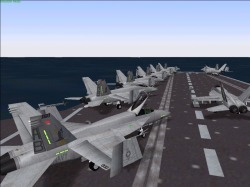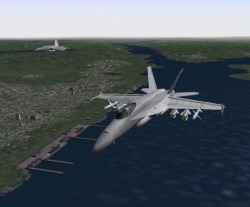|
JANE'S F/A 18 : Interview
by Leonard "Viking1" Hjalmarson |
||||
|
Catching the Wire Speaking of catching the wire, we really are modeling both the actual arresting wires and the tailhook of the aircraft. If the hook snags a wire, it will pull it out realistically as your aircraft is decelerated to a stop. Also, during this time the deck is not stationary; not only is the ship moving straight ahead, it is also pitching, rolling, and heaving depending upon the current weather and sea state. The various aircraft all have their own distinctive sounds as they spoolup for takeoff, spooldown after landing, or taxi around the deck. It really is a full airwing: in addition to the players F/A-18E, we have the F/A-18C, F-14B, E-2C, S-3B, EA-6B and the SH-60 onboard. These latter two features are points of departure from DI's Super Hornet based on our most recent information. DI have chosen not to model a pitching, rolling deck at this stage, and are not modeling hook physics with actual wires. Until we have hands on with the JANE's simulation, it's difficult to know how the differences will play out; but they sound intriguing. CJ: We recently had a real life former Hornet pilot (250+ traps) in the office and of course one of the first things he wanted to do was try out the landings. First he did a couple of day traps just to get a feel for the flight model and then he wanted to do it at night. When the moon goes down in the game it gets VERY dark, and that's how he wanted it. All you could make out were the lights on the ships landing area; there was no discernible horizon even though this was a "good weather" night. Smooth as glass he went right down the chute and caught a three wire. Afterwards, he admitted that it got his heart rate up, and that it was very close both to the real thing and to the Navy's own multi-million simulators. That obviously made the team's day. :-)
 Graphics Engine Q. The graphics engine looks considerably beyond anything seen previously from Jane's. Tell us about its key features. John Paquin: Here's a short list of the "money features." 1) Completely Dynamic Lighting: This means that you can change the angle of the sun and it will change how the game looks. The sun comes up, the moon goes down, shadows stretch down mountain slopes. Many games give the player discrete times of day by starting the game with a different palette, but you'll notice that the shadows on the sides of hills never change. Our game accurately models the daylight cycle. 2) Point Light Sources: Every object in the game that should cast light on surrounding objects - does so. This means afterburners, missile flames, explosions, fires and more. If you fly your plane off of a carrier at night, expect to see your engines lighting up the ship and the other planes on the deck. |
 Hornets over Murmansk 3) Shadow Maps: We have achieved some of the best looking shadows ever in a sim. We've done it by capturing the object's shadow from the point of view of the sun, then mathematically stretching the shadow across the countryside. The result is completely believable. 4) Light Maps: F/A-18 relies heavily on vertex lighting to achieve many of its effects. However, there are times when vertex lighting cannot produce an image of sufficient quality. For those situations, we have used light maps. Look at the sun's reflection on the water or a missile's engine lighting up the ground. These are just a few of the places we have used light mapping to enhance the final image. 5) 3D Virtual Cockpit: Allowing a completely clickable 3D cockpit was no easy task, but we managed to pull it off. Notice how little distortion there is in the MFDs, particularly the FLIR images. This is because we do not use an intermediate texture map to render the view, we mathematically re-calculate the position of the polygons to match the screen position of the MFD. This greatly reduces aliasing and sampling problems. This is another point of departure from DI's Super Hornet. The 3d cockpit is not clickable. Again, the difference is intriguing and this is ground breaking work from JANE'S. 6) Volume Clouds: We went to the WWII Fighters team, who did what are arguably the best sim clouds ever, and got the basis of their algorithm. Then we took it as far as we could. 7) Volume Explosions: We took the cloud routine and used it to make our explosions look even more realistic. When we first set out to do F/A-18, we thought we would be doing a graphical modification to the existing F-15 engine. Instead, we ended up touching virtually every line of graphics code in the game! Flight Model and Physics Q. Does F/A 18 use a full force physics model for flight? How does this impact the feeling of flight and flight performance across the envelope? Greg Kreafle: Boy, I could talk about this forever. F/A-18 uses what's called a "stability and control derivative flight model." Let me describe, in basic terms, how our flight model works. The first thing that we simulate is the atmosphere. An accurate atmosphere model is essential to a top quality flight model. Most people think that air is, well, just air. The properties of air vary drastically with temperature, and thus with altitude. The nice thing about simulating standard atmosphere is that it is easy to calculate and very well defined. With this model, we can calculate dynamic pressure (often referred to as "Q"), the speed of sound (used for Mach calculations), and temperature. The most important result of this work is the dynamic pressure coefficient. This coefficient is used to modify all of the force and moment buildup equations that we calculate. Go to Part III: Flight Model
|
|||
|
Copyright © 1997 - 2000 COMBATSIM.COM, INC. All Rights Reserved. Last Updated October 29th, 1999 |
||||
